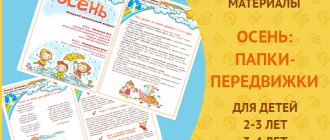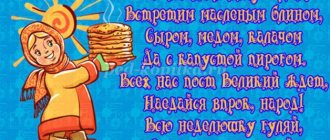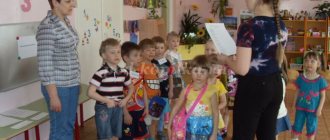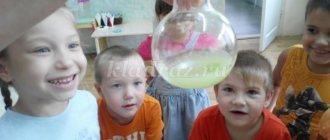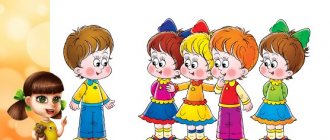"Intellectual games" (middle group)
Kazan shәһәre Maskәү district “395nche katnash tordәge balalar bakchasy”
Municipal Autonomiyale mәktәpkәchә belem institutions
urtanchylar torkeme өchen
intellectual uennar
card index
Kazan, 2021 ate
Game "Camera".
Target
: develop associative thinking, voluntary attention, memory, speech.
Game material and visual aids
: lotto cards or any other pictures.
Description
: Show the child the card for 5 seconds. Then remove it and ask them to remember what was depicted on it. If the child finds it difficult to answer, ask him a leading question: how much, what color, etc.
Game "Find the differences".
Target:
develop the ability to compare memorized objects, find similarities and differences in them.
Game material and visual aids:
story cards.
Description:
Show the child the card for 2-3 minutes. Then offer him a second card, on which some objects or actions are missing or replaced with others. The child must determine what has changed.
Game "Magpie-white-sided".
Target:
develop concentration and memory.
Game material and visual aids
: 5-6 small items (toys).
Description:
arrange objects (toys) on the table. Invite the child to look carefully at the table, remember what objects are on it, and then ask the child to turn away. Remove or replace one or more items. The child must determine what the magpie stole and what it replaced.
Game "Sleuths".
Target
: develop associative thinking, memory.
Description:
it is necessary to choose one child who will play the role of a “robber”, the rest - “detectives”. Tell some story with the children, from which it follows that the “robber” must now hide from the “detectives” and for this he needs to disguise himself. During the story, the “detectives” carefully examine the “robber,” who then goes off to disguise himself, and upon returning to the room they must find changes in his appearance.
Game "Describe the object."
Target
: teach to remember the signs and properties of an object.
Game material and visual aids
: objects familiar to the child (person, car, food, etc.).
Description:
Children, under the guidance of a teacher, choose a familiar object. The teacher suggests remembering as many distinctive features and properties of this object as possible and naming one feature at a time. The loser is the one who cannot remember anything about the item when it is his turn.
Game “Repeat the ornament”.
Target
: promote the development of concentration and memory.
Game material and visual aids
: beads, buttons, counting sticks (12 pieces each).
Description:
The teacher gives the child half of the playing material, takes the remaining half for himself, lays out an arbitrary composition of beads, then shows it to the child for 1-2 seconds. He must arrange exactly the same composition from his beads from memory. Then you can switch roles. To create the following compositions, you can add counting sticks and buttons to the beads.
Game “Remember - Draw”.
Goals:
teach conscious perception; develop concentration of attention on a memorized object.
Game material and visual aids
: a piece of paper, pencils, cardboard with images of objects.
Description
: stick six pictures on cardboard in two rows: three on top, three on bottom. The pictures should show the simplest objects: an apple, a scarf, a flag, a button, a needle, a Christmas tree, a birch leaf. Show your child the top row for one minute. The child must sketch what he saw and remembered. Then show the same bottom row of pictures and again ask the child to sketch everything that he remembers. Open all the pictures at the same time and compare how well the child’s drawings match the image.
Game “What is she like?”
Target:
promote the development of visual and auditory memory.
Description:
name an object and invite the child to imagine what this object looks like, what shape, color it is, what sounds it can make, etc. Then ask him to describe everything that he imagined. For example: an egg is oval, white or brown, with spots, raw or boiled, white and yellow inside. Then you can not only talk about the characteristics of the object, but also sketch it.
Game "Illogical Associations".
Target
: develop associative thinking.
Game material and visual aids:
cards with a picture of an object.
Description:
It is necessary to tell the child several words related to each other. For example: plate, soap, flower, street. It is better if the child has cards with images of these objects in front of him. Try with your child to find associations that would connect these words. Find a suitable picture for each association. Give space to the child’s imagination, do not limit them to logical associations. The result should be a short story.
Games for developing attention in middle preschool children
Game "Who Lives Where".
Target:
develop visual attention and memory.
Game material and visual aids:
drawings with images of families of different animals and their houses, with drawn lines connecting the animals with their houses, which are given in a chaotic order.
Description:
you need to determine where whose house is without drawing a pencil along the lines.
Game "Clap Your Hands".
Goals
: develop stability and switching of attention, cognitive activity of the child; expand your horizons.
Description:
The teacher calls the child different words; if he hears a word that means, for example, an animal, he must clap his hands. Another time, suggest that the child stand up every time he hears a word for a plant. Then combine the first and second task, that is, the child claps his hands when he hears words denoting animals, and stands up when pronouncing words denoting plants. It's good to play these games with several children.
Game "Cross out all the letters K."
Target:
develop stability, distribution and switching of attention.
Game material and visual aids:
small text (from a newspaper or magazine), pen.
Description:
Invite the child to carefully look at the letters in the text and cross out all the letters “k”. Record the time and number of errors. The task can be made more difficult by asking the child to cross out all the letters “w” and underline all the letters “u”.
Game "Change appearance".
Target:
develop observation skills.
Description
: several people play, everyone stands in one line, the leader names one child and invites him to remember the appearance of each participant in the game. This will take 1-2 minutes. Then the child turns away, the remaining participants in the game make minor changes to their costumes or hairstyles. Turning to the players, the driver must name the changes that he was able to notice.
Game "True or False".
Target:
develop attention and memory.
Description
: the teacher pronounces different phrases - true and false. If the phrase is correct, the children clap, if not, then they stomp. For example:
In winter, daisies always bloom. (Children stomp.)
Ice is frozen water. (Children clap.)
Hares have red fur. (Children stomp.)
There is no need to wash your hands before eating. (Children stomp.)
It always snows in winter. (Children clap and stomp.)
Game "Little Beetle".
Target:
develop attention and spatial thinking.
Game material and visual aids
: playing field, lined with 16 cells; buttons.
Description
: the teacher invites the child to help the “beetle” (button) get to the other end of the field, while warning that the “beetle” crawls only in zigzags. The teacher marks a short segment of the “bug’s” path: “One cell forward, two to the right, one to the left.” The child must listen carefully, remember and follow this path with a “bug” across the playing field. When the child learns to remember all the moves of the beetle, you can move on to a more complex task by asking the child to make the moves mentally and place the beetle on the desired square.
Game “Follow the pattern”.
Target:
develop concentration.
Game material and visual aids:
checkered sheet with a pattern of squares, circles, triangles.
Description
: The child continues the sample pattern (circle, square, triangle, dot, etc.) on the sheet.
Games for the development of thinking in preschool children 4-5 years old
Game "Yes-no-ka".
Goals
: learn to ask questions, find criteria for classifying objects in the surrounding world; develop listening skills and being attentive.
Description
: the teacher thinks of a word or tells a story, and the children must guess the word or explain the situation by asking the same questions, to which one of the answers can be given: “yes” or “no.”
Game "Visual yes-no-ki".
Goals:
teach to analyze; develop thinking.
Game material and visual aids
: cards with images of objects (animals) or small toys.
Description:
lay out toys or pictures (no more than 10) on the table, give the child a little time to look at them. Then ask: “What object did I wish for?” The child, using leading questions (Is it on the right half of the table? Below? Is it yellow? Is it heavy? Is it round?) identifies the hidden object (picture). To begin with, it is better for the teacher to act as the questioner. This way the child will understand the game script faster.
Game "Treasure Chest".
Target
: develop imagination, analysis skills.
Game material and visual aids:
box (bag); any edible (inedible) thing that fits in a box (bag).
Description:
Invite your child to guess what's inside using ten questions.
Game "Who was who?"
Target:
develop attention and imagination.
Description:
the child must name the state that preceded what the teacher calls him.
For example:
- Who was the old man? (As a boy.)
-What was the tree? (Rostkom.)
-What was Pinocchio? (With logs.)
Game "Outside - Inside".
Target:
learn to relate the concepts of “big” - “small”, “inside” - “outside”.
Description:
name a couple of objects to the child and ask him to say what can be inside and what can be outside. For example: house - pillow, cutlet - pan, heart - cat, fish - river, sugar - tea, etc. Then switch roles - let the child name a couple of words.
Game "I - you".
Target
: develop logical thinking, speed of reaction.
Description:
the child must quickly understand what the opponent is talking about and answer him in the same way. For example, the teacher says: “I am a rainbow!” The child must answer: “I am the sun!” The teacher continues: “I am the sky.” The child answers: “I am an airplane.” Etc. (The game is suitable for individual lessons with a child and for playing in a small children's group.)
Game "Third Man".
Target:
learn to classify objects according to the criteria specified in the conditions.
Description
: the teacher names three words, for example: “dog”, “cat”, “fish”. The child must determine: all three words refer to the designations of wildlife, but “dog” and “cat” designate animals, but “fish” does not. This means that the word fish is “superfluous”. Examples of words: birch, pine, rose; soap, shampoo, toothbrush; milk, kefir, tea.
Game "Guess by description."
Goals:
develop speech (ability to coordinate adjectives and nouns); consolidate knowledge about concepts that unite certain objects or creatures.
Description
: Prepare riddle sentences in advance that children must answer.
For example:
• A beautiful insect with colorful wings, loves to fly, feeds on nectar. (Butterfly.)
• The transport is long, consists of several parts, runs on iron rails. (Train.)
• Wild animal, lives in the forest, howls at the moon. (Wolf.)
• A wild animal with red fur always deceives in fairy tales. (Fox.)
• Fruit with yellow skin. (Lemon.)
The game “What comes first, what comes next.”
Target:
learn to arrange pictures in order of plot development.
Game material and visual aids
: sets of pictures (for example, from N. Radlov’s book “Stories in Pictures”).
Description
: the teacher takes out the pictures and shows them to the children, then says that if you put them in order, you will get an interesting story, but in order to put them correctly, you need to guess what happened first, what happened next and how it all ended. After laying out the pictures, the teacher asks the children to peel back the cards glued to them on top. If the pictures are positioned correctly, then on top of the cards you can see a correctly diverging arrow. If the arrow turns out to be incorrect, it means that the pictures are located incorrectly, you need to correct the work. After completing the task, you can invite the children to retell the story they received.
Games for speech development in preschool children 4-5 years old
Game "What is he like?"
Target
: learn to actively describe the characteristics of objects.
Description
: invite the child to bring everything square that he finds in the room. For example: a book, a box, a cube, etc. Ask him to describe all objects that are united by one characteristic - square. Let your child find and explain the similarities and differences of objects, as well as their purpose.
Game "What do you hear?"
Target:
develop hearing, the ability to recognize speech and non-speech sounds.
Game material and visual aids
: musical instruments (pipes, drum, rattles, tambourine), foil, paper, book.
Description
: the teacher sits the child on a chair with his back to himself: he should not see, only hear, and then determine what was played or what was used to produce the sound. It is advisable to start with something simple - with musical instruments, and then move on to something else: paper, foil, turning pages in a book. You can make the task more difficult by moving around the room and making a sound to the right or left of the child. Then switch roles. When answering, you can deliberately make a mistake and see if the child corrects the mistake. Ask him to repeat the sound.
The game "Who speaks how."
Target:
train phonetic memory (perceive, pronounce, distinguish sounds).
Description
: invite the child to show how a cow talks, how her baby talks, how their voices differ. The child not only learns to distinguish voices based on several characteristics, but also tries to analyze the difference between sounds.
Game "Pictures-riddles".
Target:
learn to distinguish between the main and the secondary; strengthen the skills of describing objects.
Game material and visual aids:
cards with images of various objects.
Description:
The driver is selected. He takes one of the cards out of the bag and begins to describe what is depicted on it. Players offer their answers. The next driver is the one who answered correctly first.
Game "Steps".
Target:
contribute to the expansion of vocabulary and speech development.
Description:
two teams line up opposite each other. A separate strip should be drawn between them.
The theme of the game is set. You can use the themes given in the previous game, and also name words, syllables, a specific letter or sound. You can take a step by saying the right word. The team that reaches the dividing line first wins.
Game "Prepositions".
Target:
strengthen preposition skills.
Game material and visual aids:
disposable cardboard plate, cube.
Description
: draw the plate into sectors. In each sector, write the prepositions “on”, “in”, “under”, “above”, “with”, “for”, “in front”, “to”, etc. The child throws the cube onto the plate. The sector in which the cube lands becomes playable. With the pretext of the gaming sector, the child must come up with a sentence. Keep it simple at first.
Game "Similar words".
Goals:
help to study synonyms, different meanings of the same word; learn to choose the most accurate words to describe a certain subject, avoid repetition.
Description:
Explain to the child that one and the same thing can be said in different words:
• Our kitten is cheerful. (Funny, funny, amusing, comical.)
• The weather outside today is sad. (Sad, joyless.)
• The hare is cowardly, what else can you call it? (Tearful, timid, fearful.)
• The hare runs away from the fox. How else can you say it? (He runs away, rushes, flees, flies at full speed, takes off his feet.)
Word game.
Target
: Expand words knowledge.
Description:
invite the child to name as many words as possible for toys, vegetables, trees, flowers, wild pets, birds, tools, furniture, professions.
Game "The meaning of the word."
Target
: learn to clearly express a thought, indicating the main type of use of an object, describing its characteristics.
Description
: invite the child to explain how he understands the meaning of the words “bicycle”, “knife”, “hat”, “ball”, “letter”, “umbrella”, “pillow”, “nail”, “donkey”, “fur”, “diamond”, “connect”, “shovel”, “sword”, “trouble”, “brave”, “hero”, “poem”, etc.
Literacy games for children 4-5 years old
Playing with pictures in a book or magazine.
Goals
: consolidate knowledge of the alphabet; teach word formation; develop attention and concentration.
Game material and visual aids
: picture book (children's magazine), pencil.
Description:
Together with the child, choose any letter, say it several times, remember what words he knows for this letter. Then invite the child to find and circle this letter across the entire book page. After this, together with the child, count the number of letters found.
Game "Who Lives Here?"
Goals:
teach children to form words from the given letters; develop reading skill.
Description:
Together with your child, draw a house or a train with trailers, a rocket or a ship, an airplane on thick cardboard. Insert cards with letters into the window. The child must guess what words live in this house. Example:
• A, L, I, S, E, O - fox, forest, donkey.
• K, I, N, O, T, S, L - cat, whale, elephant, movie.
Game "Slogomyach".
Target
: develop the skill of dividing words into syllables, quick thinking.
Game material and visual aids
: ball.
Description:
one player names a syllable, and the other must add an ending to this syllable so that it becomes a word. For example, you can add “rowa” to the syllable “ko” - you get “cow”; you can add “sa” to “li” - you get “fox”. It is important that children follow the rule: divide words into syllables correctly and pronounce them as they are written: “ko-ro-va”, but not “ka-ro-va”.
Game "Book Detective".
Goals
: learn to correlate letters with specific pictures; develop quick thinking.
Game material and visual aids
: books with illustrations.
Description
: think of a letter and give the child a task - find a picture in the book for this letter. If several children are playing, introduce an element of competition: the one who finds the most required pictures wins. You can complicate the game by wishing for some object depicted in the book and warning the child that the intended word, for example, contains two letters “o”. (Cow.)
Game "Sleuths".
Goals:
consolidate knowledge of the alphabet; develop the ability to correlate abstract letters with the letters that make up a word.
Game material and visual aids
: cards with letters.
Description:
Place cards with letters on different objects. The child must find all the cards and check whether they are laid out correctly, that is, whether the letter on the card corresponds to the letter with which the name of this item begins. For example, a card with the letter “k” lies on the sofa - this is wrong, it should hang, for example, on a picture. You can complicate the game by replacing cards with letters with cards with syllables.
Game "Following".
Target
: develop reading skills (introduce the arrangement of words in the text, teach reading with intonation).
Description
: The teacher and the child, sitting at the table, read a book. The teacher reads, and the child lags behind a little, repeating everything that the teacher reads. The child not only hears the text, but also sees it. It doesn’t matter that he doesn’t really read, he sees what words and sentences are made of, what punctuation marks accompany the text. He remembers the spelling of words, can recognize the simplest ones, and learns to respond to punctuation marks. The child ceases to be afraid of long words and sentences and tries to pronounce them correctly.
Game "Illustrator".
Goals:
learn how to handle a book; instill a love for books; develop narrative speech, imagination, logic.
Description
: Read a poem or short story to your child. Then offer to complete the task - match the pictures to the read text from other books. After this, ask him to retell the plot (short plot) of the work, based on the drawings he has selected.
Games for the mathematical development of middle preschool children
Game "Correct Score".
Goals:
help in mastering the order of numbers in the natural series; strengthen forward and backward counting skills.
Game material and visual aids:
ball.
Description:
children stand in a circle. Before starting, they agree in what order (direct or reverse) they will count. Then they throw the ball and call the number. The one who caught the ball continues the count by throwing the ball to the next player.
Game "Who's Where".
Target
: learn to distinguish the position of objects in space (in front, behind, between, in the middle, on the right, on the left, below, above).
Game material and visual aids
: toys.
Description:
place toys in different places in the room. Ask the child which toy is in front, behind, next to, far, etc. Ask what is on top, what is below, on the right, on the left, etc.
Game "A lot and a little."
Target:
help to understand the concepts of “many”, “few”, “one”, “several”, “more”, “less”, “equally”.
Description
: ask the child to name single objects or objects that are many (few). For example: there are many chairs, one table, many books, few animals. Place cards of different colors in front of the child. Let there be 9 green cards and 5 red cards. Ask which cards are more and which are fewer. Add 4 more red cards. What can we say now?
Game "Guess the number."
Goals:
help prepare children for basic mathematical operations of addition and subtraction; help consolidate the skills of determining the previous and subsequent numbers within the first ten.
Description
: ask, for example, which number is greater than three but less than five; what number is less than three but greater than one, etc. Think of, for example, a number within ten and ask the child to guess it. The child names different numbers, and the teacher says whether the number named is greater or less than the intended one. Then you can switch roles with your child.
Game "Counting Mosaic".
Goals:
introduce numbers; learn to match quantities with numbers.
Game material and visual aids:
counting sticks.
Description
: Together with your child, make up numbers or letters using counting sticks. Invite the child to place the corresponding number of counting sticks next to the given number.
Game "Dot Traveler".
Goals
: introduce the basics of writing numbers; develop fine motor skills.
Game material and visual aids
: checkered notebook, pen.
Description:
The teacher sits down at the table, puts the notebook down correctly, and shows the child how to hold a pen correctly. Offers to play dot-traveler. To do this, you need to invite the child to put a dot in the upper right corner of the cell, then in the fourth cell of the left corner at the bottom of the notebook, etc.
Game "Reading and counting".
Goals:
help to understand the concepts of “many”, “little”, “one”, several”, “more”, “less”, “equally”, “as much”, “as much”; develop the ability to compare objects by size.
Game material and visual aids
: counting sticks.
Description:
When reading a book to a child, ask him to put aside as many counting sticks as, for example, there were animals in the fairy tale. After counting how many animals there are in the fairy tale, ask who there were more, who were fewer, and who were the same. Compare toys by size: who is bigger - a bunny or a bear? Who is smaller? Who is the same height?
Games to study the plant world for children 4-5 years old
Game "How do trees live?"
Goals:
develop speech; help in studying the plant world.
Game material and visual aids
: cards with images of trees in different seasons (summer - a green tree, autumn - a tree with yellow leaves, winter - a tree without leaves, spring - a tree with swollen buds).
Description:
find out what time of year it is now. What the trees look like, what kind of leaves they have. Ask your child if he knows what happens to trees in autumn, spring, winter? Look at the pictures. Tell your child that the change of seasons affects the state of plants (in winter all plants fall asleep, in spring they awaken, in autumn they prepare for sleep, etc.).
Game “Where is whose leaf?”
Goals
: develop the ability to classify objects by characteristics, memory, attention; help in studying the plant world.
Game material and visual aids
: cards with images of trees (oak, maple), leaves of these trees, cut out of paper or real.
Description
: Mix the leaves. Tell your child a fairy tale about how an evil wind tore all the leaves from the trees and mixed them up. They feel cold lying on the ground and want to go back to their trees. We need to help the leaves find their mother (father) - the tree. Invite your child to put the leaves near the corresponding tree. In the first lessons, choose leaves of a memorable shape (maple, oak, rowan). As you study trees, increase the number of varieties of leaves and trees. Select leaves of different trees that are similar in shape, carefully examine them, finding differences.
Game "Orchard".
Goals
: develop speech, classification skills; introduce you to the plant world.
Game material and visual aids:
dummies of fruits and vegetables; cards with images of fruit trees.
Description
: Place fruits and vegetables in front of the child. Explain that the doll wanted to make compote, but the fruits were mixed with vegetables, and she couldn’t choose them because she didn’t know how they differed from each other. After the weight differences are identified, invite the child to separate fruits from vegetables. Ask if the child knows where fruits grow. Look at the fruit trees shown in the pictures. Cut an apple or orange and show your child the seeds hidden in them. To summarize: Fruits grow on trees. Trees are called fruit trees. Specially planted, such trees form an orchard. You can talk about what is prepared from fruits and what dishes they are added to.
Game "Indoor Flowers".
Goals:
develop the skill of independence; introduce you to the plant world.
Description
: if there are indoor plants, invite your child to take care of them. Give him a watering can, teach him how to loosen the soil, and wipe the leaves of plants with a damp sponge. Tell us that the plants have come a long way before reaching the windowsill. After all, many of them came to us from distant countries - India, Mexico, Africa, etc. If the child expresses a desire, find these countries on the world map. Continuing the story, explain that the weather conditions of those countries are different from ours, therefore each flower requires special care: sun or shade, a lot or little water, heat or coolness. When offering to water this or that plant, note: “To water this flower, you need to put very little water in the watering can, but this one likes to drink a lot, so please try to get a lot of water.” Explain to the child why the holes are made in the pots, why the soil needs to be loosened, why the dust should be wiped off the leaves, etc.
Intellectual game for children of senior preschool age
Intellectual game for children 5-7 years old “Young talent”
Goal: to create conditions for generalizing and systematizing the knowledge of children of senior preschool age with pronounced abilities. Objectives: 1. Contribute to consolidation of acquired knowledge and skills; 2. Develop interest in intellectual activity, the desire to play games with mathematical, logical and artistic content; 3. Show persistence, the ability to strictly follow instructions, determination, mutual assistance, resourcefulness and ingenuity; 4. Encourage individuals to independently search for necessary information and solve problem situations; 5. To cultivate in children the ability to take initiative in order to gain new knowledge, perseverance, determination, ingenuity, and mutual assistance. Equipment: envelopes with entertaining puzzles, videos with pictures from fairy tales, easel, markers, illustrations of geometric shapes, prizes. Progress of the game: Host: Good afternoon. We are glad to see you today at our intellectual game “Young Talent”. The game is attended by a team of senior group No. 1 and a team of senior group No. 2. I ask the teams to introduce themselves and greet each other. (Greetings from teams and captains) Team “Whychki” “We are inquisitive minds, We have questions for you.” “Why” is a favorite question, Helps us grow.” Team “Knowledgeable” “If you want to know a lot, you should read a lot.” Our motto: “Don’t lose heart! Go through everything and find out everything! Presenter: To sum up the results for each task, we have selected a jury: (presentation of the jury members). Our game consists of five tasks. 1 task “Visiting a fairy tale”: In this task, teams need to answer 10 questions. A limited amount of time is allotted for this task: 2 minutes for each team. When the time is up, a beep sounds. For each correct answer to a question, teams receive 1 point. Questions for the “Why” team: 1. The name of the boy who was carried away by the Geese-Swans? (Ivanushka). 2. Who is stirred by sour cream, cold at the window? (Kolobok). 3. The hero of a Russian folk tale who rode a stove? (Emelya) 4. The harmful old woman from Russian folk tales? (Baba Yaga) 5. Little girl living in a flower? (Thumbelina) 6. Wooden doll with a long nose. (Pinocchio) 7. In what fairy tale did the carriage turn into a pumpkin? (In "Cinderella") 8. The evil owner of the puppet theater with a long beard. (Karabas-Barabas) 9. What type of transport did the bears use in the fairy tale “The Cockroach”? (On a bicycle) 10. What did the crocodile use to extinguish the blue sea in the fairy tale “Confusion”? (Pies, and pancakes, and dried mushrooms.) Questions for the “Knowledge” team: 1. The name of the girl whose brother turned into a little goat? (Alyonushka) 2. Fairy-tale onion boy? (Chipolino) 3. A harmful old woman with a rat. (Shapoklyak) 4. Cheburashka’s green friend? (Crocodile Gena) 5. Who swallowed the washcloth in the fairy tale “Moidodyr”? (Crocodile) 6. What gift did the fleas bring to the Tsokotukha Fly? (Boots) 7. Fairytale girl with blue hair? (Malvina) 8. What were the names of the three little pigs? (Nif-nif, Naf-naf, Nuf-nuf) 9. What was the name of the grandmother from whom all the dishes ran away? (Fedora) 10. How many pounds of chocolate did the elephant ask for his son in the fairy tale “Telephone”? (Five or six. Presenter: while our jury sums up the first task, you and I will sing the song “The sun is out”, which will cheer us up. Task 2. “Entertaining problems in a magic box” Presenter: Each child from the team takes turns taking it out of the box envelope with a problem. The presenter reads the problem, and the child who pulled the envelope answers, but if he cannot answer, the team helps him. For each correct answer without help, the team receives 2 points, and if the participant was helped with the answer, then the team receives 1 point. 1. Grandma Masha has a granddaughter Dasha, a cat Fluff, a dog Druzhok. How many grandchildren does grandma have? 2. A birch tree grew in the forest. Apples grew on it: 1 green, 2 red, 1 yellow. How many apples are there in total on the tree? 3 . Birds were flying over the site: a pigeon, a pike, two tits. How many birds are there in total? 4. What time of year is it now? 5. List all the winter months? 6. Is it morning or evening? 7. What other parts of the day do you know? 8. Today Thursday, and tomorrow? 9. Name the days of the week, starting with Monday. 10. What is your favorite day of the week? Which one is he? 11. Who is standing to your right? 12. Who is standing behind? 13. How is time measured? 14. How is temperature measured? 15. How can you measure length or height? 16. How is weight measured? Presenter: Well done team, you completed the task. While our jury is summing up the results, we are announcing a competition of riddles for fans: 1. The longest necked animal. (Giraffe) 2. Who carries the baby in the bag? (Kangaroo) 3. A bird that cannot fly and is not afraid of frost? (Penguin) 4. Long-eared coward. (Hare) 5. A beautiful but inedible mushroom. (Amanita) 6. The largest berry. (Watermelon) 7. A flower with a yellow center and white petals. (Chamomile) 8. Red mushrooms with an animal name. (Chanterelles) 9. What comes after winter? (Spring) 10. 2. When do the leaves fall from the trees? (In autumn) 11. 3. The hottest time of the year. (Summer) 12. The shortest month of the year. (February) 13. Snowy season. (Winter) 14. Black forest berry. (Blueberry) 15. Fruit that looks like a light bulb. (Pear) 16. What berries does the bear like? (To Malin) 3rd task “Captain Competition” Presenter: Team captains are asked to complete two tasks. The first task is logic puzzles. The captains need to listen carefully to the problem and answer the question posed: 1. Anton and Nikita played with different toys - a toy car and a pyramid. Anton did not play with the pyramid. What did each of the boys play with? 2. Sasha and Egor drank tea from cups of different colors: yellow and red. Sasha did not drink tea from a yellow cup. Which cup did each boy drink tea from? The second task is video questions. The captains will be shown 6 pictures each depicting heroes from different fairy tales. Your task is to name these fairy tales. Presenter: While the counting commission is counting the results of the 3rd round, I announce a musical break. Presenter: The jury is given the floor to announce the results of task 3. 4 task. “Smart Figures” Presenter: The teams are offered a visual memory task. Teams look at a poster depicting geometric shapes for 30 seconds, then are asked to draw the same image on an easel from memory. Presenter: Musical break. The jury is given the floor based on the results of the 4th task. 5 task. “Fairy-tale guest” Presenter: In this competition, a surprise awaits you, it will be led by a fairy-tale character. Guess: which Pushkin fairy-tale heroine received from her owner a home made of pure crystal and a guard of honor for her jewelry work and vocal skill. (The squirrel from “The Tale of Tsar Saltan.”) The squirrel runs in. Squirrel: You guessed correctly! Hello! I came to your game and prepared very difficult questions: 1. Grandma Dasha has a grandson Pasha, a cat Fluff, and a dog Druzhok. How many grandchildren does she have? (one) 2. Which figure has neither beginning nor end? (circle) 3. Who swims faster - a duckling or a chicken? 4. Who will reach the flower faster - a butterfly or a caterpillar? 5. Two fish flew over the forest. Two landed. How many flew away? 6. What do crocodiles eat at the North Pole? 7. There were children's books on the shelf. The dog ran up and took one book, then another, then two more books. How many books has the dog read? 8. The hare invited two bears and three hedgehogs for the New Year. How many devices should he supply? 9. Who will moo louder – the rooster or the cow? 10. What color is Kolobok’s hair? Squirrel: Well done guys, you completed the task! And now, while the jury sums up the results, we will play my favorite game “Distorted Mirror”; I will show the movement, and you perform the movement in reverse (for example, the leader leans to the right, and the children to the left, leans forward, and the children back, etc. .) The results of the intellectual game are summed up and Squirrel rewards the winners.
We recommend watching:
Intellectual game for children 6-7 years old. The child’s readiness for school Game “Clever and Clever Girls” for children of the preparatory group of kindergarten Game “What? Where? When?" in the preparatory group Logical tasks for children 5-7 years old
Similar articles:
What are educational games for preschoolers
Outdoor games - tag for preschool children
Educational games in pictures for children 6-7 years old
Exercises to prepare the hand for writing for older preschoolers
Life safety games in the senior group
